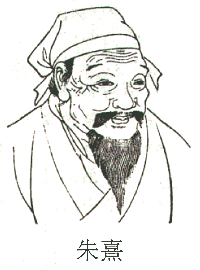The �m�P���D�j�H�n Zhou1 Yi4 - Da4 Xiang4 is one of the 10 primary commentaries on the �m���g�n Yi4 Jing1 (Book of Changes). These ten commentaries, known collectively as the �Q�l Shi2 Yi4 "Ten Wings", are traditionally attributed to the authorship of �դl Kong3zi3 (Confucius, c.551?-c.479?), though in reality they contain a great variety of material of uneven quality, written in discernibly different historical styles.
The name �m�j�H�n Da4 Xiang4, which may be translated as The Great Symbolism, is written in Chinese with two pictographic characters: �j 'big-man; great', and �H 'elephant; ivory'. These characters in their Small-Seal forms may be seen below (between the two portraits), to be read from top to bottom: �m���D�j�H�n Yi4 Da4 Xiang4. The meaning 'symbolism' for �H xiang4 is sometimes said in traditional Chinese lexicography to be an extension from this primary meaning, relating to the carving of ivory. Elephant: Ivory: Image: Imagery. Others would see the usage as a borrowing of the animal substantive for the other (nearly?) homophonous senses for which there were originally no independant writings. The �M Qing1 Scholar �q�ɵ� Duan4 Yu4cai2 (see LTBA 18.2:151) said that the proper writing of �H 'image' is ���C
Within the traditions surrounding the ancient �m���g�n Yi4 Jing1 (Book of Changes, also called �m�P���n Zhou1 Yi4 "The Permutational Philosophy of the Zhou1 Dynasty") the term �H xiang4 refers to the image which the diviner sees while regarding the hexagrams built-up in the divination process. �m�j�H�n The Great Symbolism is composed of 64 verses, each of which elaborates the imagery of a particular hexagram. This Great Symbolism is termed "Great" in relation to another of the Ten Wings, �m�p�H�n Xiao3 Xiang4, The Small Symbolism which gives a close treatment of the imagery of the individual lines of the 64 hexagrams. The text of The Small Symbolism is considerably longer than the Great Symbolism, and derives its name in part relative to the more fundamental principles explored in the Great Symbolism. The names �j Da4 "Great" and �p Xiao3 "Small" (or "Greater" and "Lesser") reflect also a qualitative judgement as to the poetic superiority of the The Great Symbolism. Among all of the many Sections of the ancient Book of Changes, The Great Symbolism is in fact the most beautiful elaboration of its secrets, a work repaying careful study.
The HyperText version provided on this web site is that of one of the primary traditional texts, that of �n�����Q the Southern Song4 Classicist Zhu1 Xi1, who lived from 1130-1200 A.D. The complete text (including the commentary of ���Q Zhu1 Xi1) from which this �m�j�H�n Great Symbolism is extracted, is called �m�P���D���q�n Zhou1Yi4-Ben3Yi4, "The Permutational Philosophy of the Zhou1 Dynasty - [With Notes on] The Original Meaning".
The encoding of this electronic text is Big5 (Traditional Chinese), and so substitution has been required in two cases where characters occurring in the printed version (Chengdu 1989) are not found in Big5. These characters, hyper-linked in column four of the Da4Xiang4.html table are: (1)  wu2 'without' (in the present electronic document written �L in Big5) which occurs (7 times) in the traditional printed version in the form adopted as "simplified" �� in GB (Mainland National Standard Simplified Chinese) encoding, in Unicode 2.0 Unihan as U+65E0; (2)
wu2 'without' (in the present electronic document written �L in Big5) which occurs (7 times) in the traditional printed version in the form adopted as "simplified" �� in GB (Mainland National Standard Simplified Chinese) encoding, in Unicode 2.0 Unihan as U+65E0; (2)  li4 'brilliant governance' occurring in the text for ���i
li4 'brilliant governance' occurring in the text for ���i  �A written ݰ in GB encoding, in Unicode 2.0 Unihan as U+8385, which in the present electronic document is written with the similar character �Y containing the additional "water radical" at the inside left. The character should be written with �J over ��A without �����ǡC
�A written ݰ in GB encoding, in Unicode 2.0 Unihan as U+8385, which in the present electronic document is written with the similar character �Y containing the additional "water radical" at the inside left. The character should be written with �J over ��A without �����ǡC




